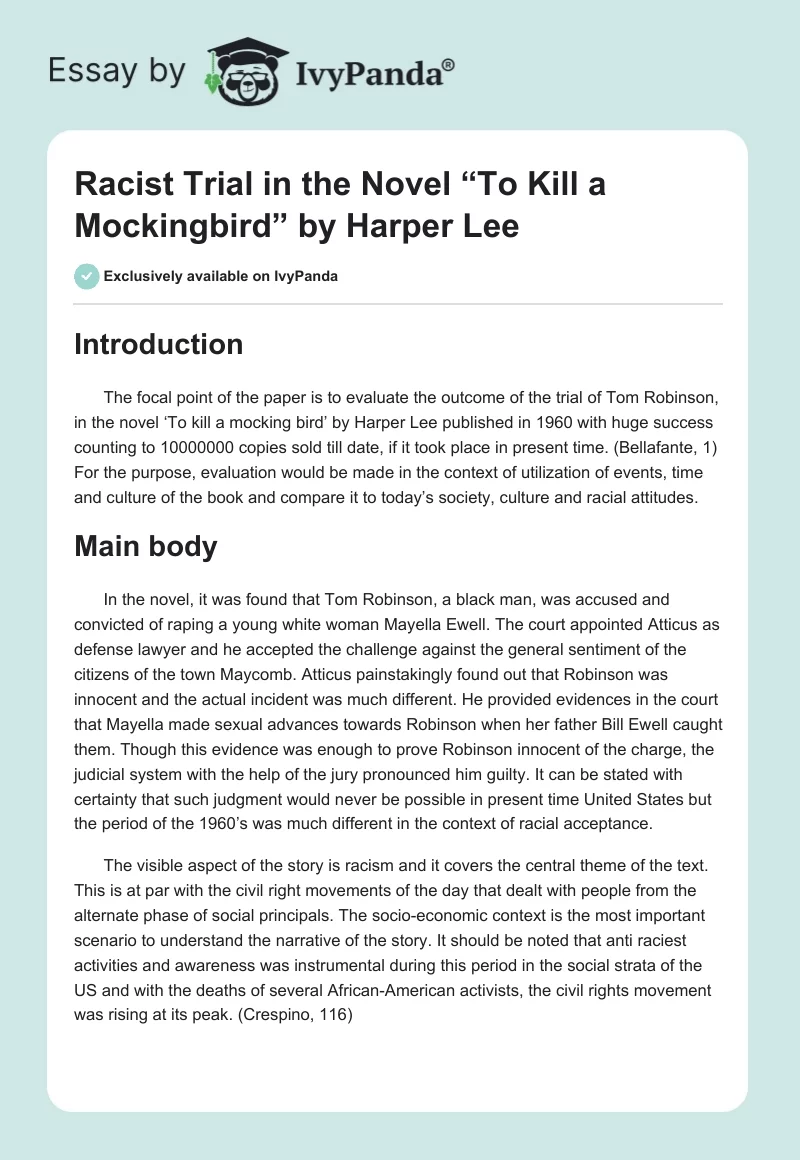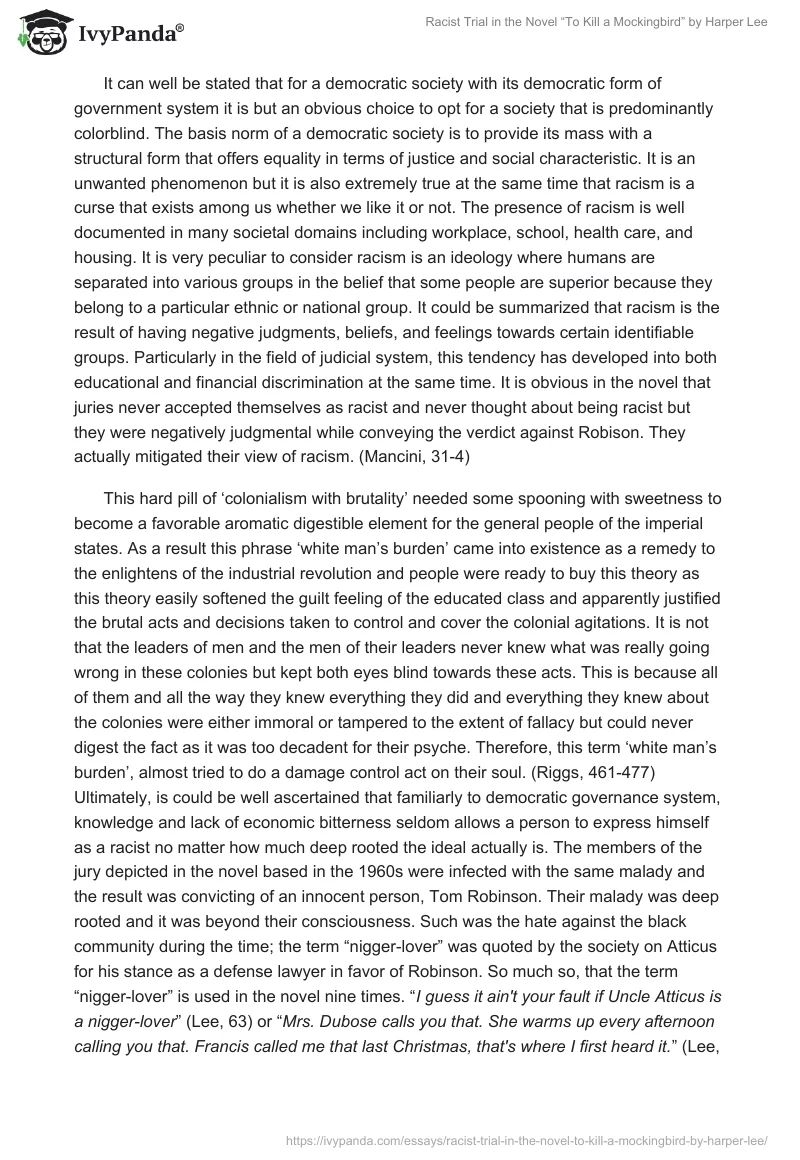Introduction
The focal point of the paper is to evaluate the outcome of the trial of Tom Robinson, in the novel ‘To kill a mocking bird’ by Harper Lee published in 1960 with huge success counting to 10000000 copies sold till date, if it took place in present time. (Bellafante, 1) For the purpose, evaluation would be made in the context of utilization of events, time and culture of the book and compare it to today’s society, culture and racial attitudes.
Main body
In the novel, it was found that Tom Robinson, a black man, was accused and convicted of raping a young white woman Mayella Ewell. The court appointed Atticus as defense lawyer and he accepted the challenge against the general sentiment of the citizens of the town Maycomb. Atticus painstakingly found out that Robinson was innocent and the actual incident was much different. He provided evidences in the court that Mayella made sexual advances towards Robinson when her father Bill Ewell caught them. Though this evidence was enough to prove Robinson innocent of the charge, the judicial system with the help of the jury pronounced him guilty. It can be stated with certainty that such judgment would never be possible in present time United States but the period of the 1960’s was much different in the context of racial acceptance.
The visible aspect of the story is racism and it covers the central theme of the text. This is at par with the civil right movements of the day that dealt with people from the alternate phase of social principals. The socio-economic context is the most important scenario to understand the narrative of the story. It should be noted that anti raciest activities and awareness was instrumental during this period in the social strata of the US and with the deaths of several African-American activists, the civil rights movement was rising at its peak. (Crespino, 116)
It can well be stated that for a democratic society with its democratic form of government system it is but an obvious choice to opt for a society that is predominantly colorblind. The basis norm of a democratic society is to provide its mass with a structural form that offers equality in terms of justice and social characteristic. It is an unwanted phenomenon but it is also extremely true at the same time that racism is a curse that exists among us whether we like it or not. The presence of racism is well documented in many societal domains including workplace, school, health care, and housing. It is very peculiar to consider racism is an ideology where humans are separated into various groups in the belief that some people are superior because they belong to a particular ethnic or national group. It could be summarized that racism is the result of having negative judgments, beliefs, and feelings towards certain identifiable groups. Particularly in the field of judicial system, this tendency has developed into both educational and financial discrimination at the same time. It is obvious in the novel that juries never accepted themselves as racist and never thought about being racist but they were negatively judgmental while conveying the verdict against Robison. They actually mitigated their view of racism. (Mancini, 31-4)
This hard pill of ‘colonialism with brutality’ needed some spooning with sweetness to become a favorable aromatic digestible element for the general people of the imperial states. As a result this phrase ‘white man’s burden’ came into existence as a remedy to the enlightens of the industrial revolution and people were ready to buy this theory as this theory easily softened the guilt feeling of the educated class and apparently justified the brutal acts and decisions taken to control and cover the colonial agitations. It is not that the leaders of men and the men of their leaders never knew what was really going wrong in these colonies but kept both eyes blind towards these acts. This is because all of them and all the way they knew everything they did and everything they knew about the colonies were either immoral or tampered to the extent of fallacy but could never digest the fact as it was too decadent for their psyche. Therefore, this term ‘white man’s burden’, almost tried to do a damage control act on their soul. (Riggs, 461-477) Ultimately, is could be well ascertained that familiarly to democratic governance system, knowledge and lack of economic bitterness seldom allows a person to express himself as a racist no matter how much deep rooted the ideal actually is. The members of the jury depicted in the novel based in the 1960s were infected with the same malady and the result was convicting of an innocent person, Tom Robinson. Their malady was deep rooted and it was beyond their consciousness. Such was the hate against the black community during the time; the term “nigger-lover” was quoted by the society on Atticus for his stance as a defense lawyer in favor of Robinson. So much so, that the term “nigger-lover” is used in the novel nine times. “I guess it ain’t your fault if Uncle Atticus is a nigger-lover” (Lee, 63) or “Mrs. Dubose calls you that. She warms up every afternoon calling you that. Francis called me that last Christmas, that’s where I first heard it.” (Lee, 83) Lines like these make it possible for us to understand the nature of hate the white society possessed against the black community. (Guerin, 29-45)
Appadurai states in this context that “various forms of uncertainty create intolerable anxiety about the relationship of many individuals to state provided goods- ranging from housing and health to safety and sanitation- since these elements are frequently directly tied to who ‘you’ are and thus to who ‘they’ are.” (Appadurai, 6) However, it should be mentioned in this context that in the modern concept of society it is not possible to stay only in connection of a specified set of personnel and detach from the other echelons of life, be it emotional of professional. It can be mentioned in this section of discussion that the term “community” in sociology indicates a group of people who share social interaction and some common ties between themselves and the other members of the group. It also indicates an area where the group gathers for at least some of the time. Following a principal it can be stated that in general sense it could be stated that a person as an individual belongs to few specified groups initially. First there is the ethnic community were the individual belongs, second it is the faith or belief, both in religious and idealist manner, and third is the community of the professional level. It is obvious the judicial system and the jury was a part of the existing society of the 1960s and the verdict they gave definitely reflected the general feeling of the mass in terms of racism. In today’s world of US judicial system and social awareness, this would have never happened but as it is stated earlier the early parts of the 1960s were much volatile than today in terms of racism. (Johnson, 124)
It is thus no wonder that famous civil right activist Mary McLeod Bethune believes that it is very peculiar to consider racism is an ideology where humans are separated into various groups in the belief that some people are superior because they belong to a particular ethnic or national group. At the same time it should be remembered that the respected governor of Florida David Sholtz once said in an interview that racism is an unwanted fact but it is also extremely true at the same time that racism is a curse that exists among us whether we like it or not. However, it is also true that the United States of America has changed itself over the period and it is much receptive in terms of color, cast, race and beliefs. (Hook, 210-214)
Conclusion
In conclusion, it should be mentioned that one of the most compelling developments of our age is the recognition of multicultural of multiracial society and the manner they translate to each individual. The challenge is not just in recognizing other races but more importantly, the culture and heritage of people must also be recognized. Are people becoming aware and accepting of others? Are people’s view and minds growing broader? Is intolerance being decreased? Are we now on the path of building a society that does not just recognizes cultural and racial diversity but celebrates it? As much as we would like to think that we are accomplishing this, current evidences show that there is still much to do. However, returning to the main point of discussion, it should be stated that under the present situation, the jury would definitely judge Robinson innocent and he would have been a free man.
Works Cited
Appadurai, Arjun; Fear of Small Numbers: An Essay on the Geography of Anger (Public Planet); Duke University Press; June 2006; pp- 6
Bellafante, Ginia; Harper Lee, Gregarious for a Day; (The New York Times: 2006). Web.
Crespino, Joseph. “The Strange Career of Atticus Finch”. Southern Cultures (University of North Carolina Press: 2000)
Guerin, Bernard; Combating prejudice and racism: new interventions from a functional analysis of racist language; Journal of Community & Applied Social Psychology; 13, 1, 29-45; (Department of Psychology, University of Waikato, Hamilton, New Zealand: 2006)
Hook, Derek; Racism; Journal of Community & Applied Social Psychology; 16, 3, 207-232; (Institute of Social Psychology, London School of Economics and Political Science, London, UK; Research Associate, School of Human and Community Development, University of the Witwatersrand, South Africa: 2008)
Johnson, Claudia. Understanding To Kill a Mockingbird: A Student Casebook to Issues, Sources, and Historic Documents. (Greenwood Press: 1994)
Lee, Harper; To Kill a Mockingbird; (J. B. Lippincott & Co: 1960)
Mancini, Candice, ed. Racism in Harper Lee’s To Kill a Mockingbird, (The Gale Group: 2008)
Riggs, Damien W. & Martha Augoustinos; The psychic life of colonial power: racialised subjectivities, bodies and methods; Journal of Community & Applied Social Psychology; 15, 6, 461-477; (Department of Psychology, The University of Adelaide, South Australia, Australia: 2005)


